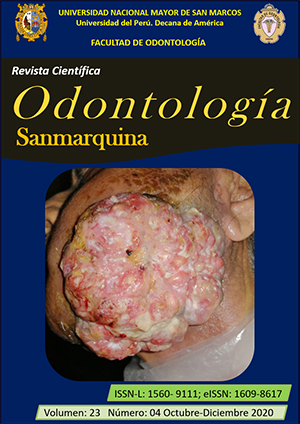Allergies in dental care
DOI:
https://doi.org/10.15381/os.v23i4.17927Keywords:
Dentistry, Allergy and Immunology, Hypersensitivity, Anaphylaxis, (source: MeSH NLM)Abstract
Dental staff and patients are exposed to numerous allergens in dental care, for this reason, this review aims to provide guidelines for the identification of allergens in the dental practice, describe the signs and symptoms of allergic reactions, and advise its treatment. Allergens include latex, metals, local anesthetics, endodontic materials, impression materials, and drugs. Dental allergens mainly cause type I and IV hypersensitivity reactions. In the diagnostic process, an anamnesis and a thorough clinical examination are required to identify the suspected allergen. In addition, complementary tests such as patch and puncture tests can be used. The dentist must recognize the signs and symptoms associated with allergic reactions, identify the cause and avoid exposure of the patient or dental personnel. In the event, that an allergic reaction occurs, its treatment will include elimination of the allergen, and the use of antihistamines and corticosteroids. If the case is an anaphylactic shock, epinephrine is the drug of choice. Dental professionals need to be prepared to identify and manage hypersensitivity reactions, and to refer the immunologist/allergist specialist if necessary.
Downloads
Downloads
Published
Issue
Section
License
Copyright (c) 2020 Daniela Catalina Martinez Camus, Sebastián Rodolfo Yévenes Huaiquinao, Catalina Javiera Rodríguez Álvarez

This work is licensed under a Creative Commons Attribution-NonCommercial-ShareAlike 4.0 International License.
AUTHORS RETAIN THEIR RIGHTS:
a. Authors retain their trade mark rights and patent, and also on any process or procedure described in the article.
b. Authors retain their right to share, copy, distribute, perform and publicly communicate their article (eg, to place their article in an institutional repository or publish it in a book), with an acknowledgment of its initial publication in the Odontología Sanmarquina.
c. Authors retain theirs right to make a subsequent publication of their work, to use the article or any part thereof (eg a compilation of his papers, lecture notes, thesis, or a book), always indicating the source of publication (the originator of the work, journal, volume, number and date).






